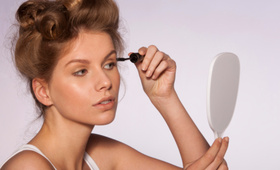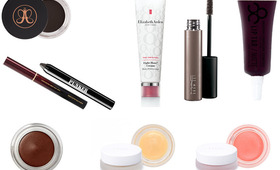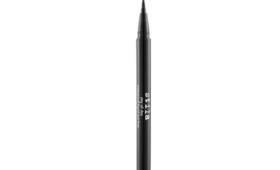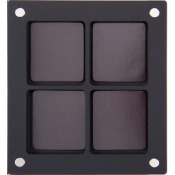Building Your Kit Part 8: The Complete Guide to Eye Shadow
Published May 18, 2013

Eye shadows offer endless creativity. They just may be the most exciting product for both makeup artists and makeup lovers to buy. These days, the number of colors, textures, and formulations is near infinite. But with all the choices, compiling a makeup kit or adding to your everyday shadow regime can get a little mind-numbing. Here are a few things to think about as you build your perfect eye kit.
Even in the basic powder shadow category, brands can be very different due to the amount of pigment versus filler they use, as well as the process in which they press product into pans. Experiment and find the formulas that work best for you and deliver the results you desire. For instance, you might prefer a highly pigmented powder with a small amount of filler that feels dry to the touch, or favor a shadow that feels soft and creamy on your brush and has a lighter pigment load and color payoff. It’s all about discovering your preferences and finding your favorites.
Putting a Palette Together
I’ve found that palettes are the perfect way to carry makeup for professional work, and they also fit well into a tote or makeup bag. You can purchase pre-made palettes—available in pretty much every price point—from many brands, or buy brand-specific empty palettes (such as Inglot’s) and build your own customized collection within one color range. You can also buy empty palettes or containers that allow you to add in pans of eye shadow from multiple brands. Some of my favorites are from Z•Palette and Alcone.
A word of advice: keep it simple. When compiling your palette, don’t get caught up in the excitement of buying the most daring shades. So many artists want to get all of the brightest and boldest colors and textures, but basic shadows will be the basis of your application and lay the groundwork for great makeup.
Check for Quality
I recommend checking the quality of the product before you purchase. Look at reviews online and speak to other artists about what they love or perhaps dislike about the product. I’m not a product snob, but the difference in quality between pro and prestige versus mass products can be obvious and measurable. A few key questions to ask yourself:
• Does the shadow allow you versatility in application? Meaning, can you apply it both sheer and with more full coverage?
• When using a variety of brushes, will it have a smooth consistency?
• Is it durable for high-intensity jobs and situations? In other words, does the product cause a lot of fallout on the face during application?
1. The Highlighting Palette
A highlighting palette made up of lighter shades and base shadows is an absolute must-have. This group includes white, light beige, cream, vanilla, peach, and buttercream shades, as well as soft pinks and apricots. The lighter colors can be used to draw attention to a feature, cause a certain area to pop, or simply make a part of the face look more dominant.

I prefer to keep these shades in matte or satin consistencies, because you don’t always want your highlight shades to have texture. Base shades should always be matte, or else the shimmer or frost will show through.
2. The Contouring Palette
Next, to build in shape and definition, think about a contouring palette which include darker colors that will recess an area or make it appear smaller. You can also use contouring shades to line and define brows, eye lids, or any area that needs depth or dimension. This group of shades should contain matte shadows in various cool and warm browns, deep burgundies, rich greys, and neutrals on the darker side of the spectrum—including black.

3. The Color Palettes
Once you have your fundamentals for shape and form, let your creative side come into play by building your color palettes. Here, let your imagination run wild. But still, be strategic and think about what you can combine for unlimited possibility.** **


I prefer to separate palettes into warm and cool, and then arrange into common color families. I also like to keep matte and satin textured shadows separate from frosts, shimmers, and glitters so loose particles don’t end up compromising your flat shadows. Think about what works on your clients and what you need to complete the job at hand. Represent all of your primary and secondary colors, tints, shades, and tones. Then, go crazy with an endless array of your faves: deep rich reds, bright yellows, cool blues, greens, pinks, violets, indigos—whatever your heart desires in both soft and strong colors!
4. The Texture Palette
You will also need a texture palette—something made up of various frosts that highlight, change the surface, or add impact. Metallic eye shadows also fit well into this group and allow you to transform any eye into numerous looks. Stay aware of seasonal trends and what’s on the red carpet and runway for the latest must-have shadow shades.

Now you know how to meet the needs of any client. Eye shadows can lay the groundwork for a look’s shape, texture, or tone, from traditional to bold. Be smart about your palettes and arm yourself with the right shadows, so you can truly transform any application with a simple swipe.
Check out Parts 1–7 of James Vincent’s Building Your Kit series here, and stay tuned for Part 9, coming soon!
As Director of Artistry for The Makeup Show, The Powder Group and On Makeup Magazine, makeup artist James Vincent has touched every facet of the industry with his talent. With specialties in film and theatre, television and celebrity work, editorial and runway work, James is foremast a passionate educator, training for brands such as MAC, Stila, CNN and Lancome. He continues to inspire the next wave of artists with his beauty expertise. Follow James on Twitter @JVincentmakeup.
Featured Products
You Might Also Like
-

Lip Sets
NYX Cosmetics Haute Jersey Leopard Couture Palette
- 28
-

Mascara
Makeup for Beginners: How to Choose (and Use) Mascara
- 820
-

Mascara
Make the Most out of Your Mascara Wand
- 447
-

Building Your Kit
Building Your Kit Part 24: Getting Grunge Beauty Right
- 705
-

Eye Liners
Stila Stay All Day Waterproof Liquid Liner
- 49
-

Eyes
Metallics For Every Skin Tone
- 152















